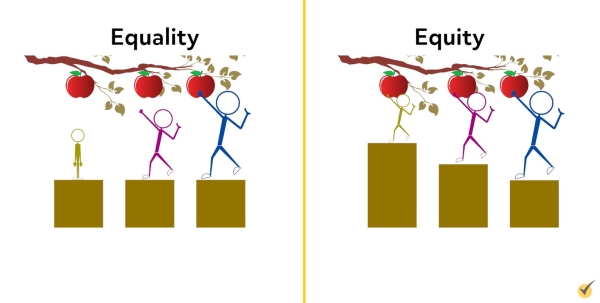
Consider the following situation. Two students are in the same science classroom. The teacher assigns the class a chapter to read independently in the textbook on the topic of photosynthesis, which is followed up immediately by a quiz.
Both students have access to the same textbook and are given the same amount of time to read the chapter. However, one student is a native English speaker, while the other is an English language learner in the beginning stages of proficiency. The textbook is only available in printed English.
Is this situation equal? Is it equitable? What’s the difference?
In this video, we will define the terms equal and equitable and explain how the two are different. We will also describe steps that teachers and other educational stakeholders can take to make the classroom more equitable for all students.
Equality and Equity: What’s the Difference?
Though the terms equality and equity are often used interchangeably, they have different meanings.
Take a look at this image. What does it tell us about equality and equity?

Equality refers to giving everyone the same resources and opportunities, regardless of their individual needs. In this image, everyone is given the same stool, despite their different heights. Even when given the exact same resources, some may not succeed.
Equity, on the other hand, refers to providing everyone with the support needed to overcome barriers to success. It focuses on having fair outcomes. In this image, each person is still given a stool, but the customized sizes ensure each person can successfully reach the apples.
Importance of Equality and Equity in Education
Equality and equity are both important in education.
First, all students have a right to high-quality education, and they are all expected to meet the same standards as their peers as determined by state and district requirements.
However, each classroom contains a diverse group of students with differing needs, which can affect ways students interact with content, make meaning, and succeed on learning objectives. Students may require different types and levels of support in order to reach the same outcomes as their peers.
Barriers to Equity
Consider the following situations.
- Julia’s family faces food insecurity, and it is not uncommon for her to skip meals. On the morning of her state standardized test, which helps her determine eligibility for graduation, Julia has not eaten breakfast. Her hunger makes it difficult to concentrate on answering the test questions.
- Sam has an audio processing disorder and struggles to comprehend his teacher’s oral explanations and modeling. As a result, he struggles on the independent practice activities and assessments that follow.
- Lynn is struggling with a current concept in her algebra class. The teacher offers tutorials once a week after school, but staying would cause Lynn to miss the bus. She lives several miles away from school, and her family does not have transportation to pick her up. Therefore, Lynn skips the tutorials.
These scenarios highlight just a few of the barriers that may inhibit students’ abilities to reach the same outcomes as their peers. These barriers include:
- Access to food, housing, transportation, school supplies, and technology
- Language and cultural differences
- Differing levels of prior knowledge and background experiences
- Differing levels of support at home
- Differing strengths, needs, or disabilities
Ways to Increase Equity in the Classroom
Overcoming these barriers requires action and collaboration on multiple fronts.
For their part, districts and schools coordinate how to distribute resources, including serving meals, lending out laptops, coordinating bus routes, and translating school correspondence into multiple languages. They also employ school counselors, special education teachers, and other specialists who work with classroom teachers to identify and address student needs.
Classroom teachers must also recognize and respond to differing student needs. Some steps they may take include:
- Using formative and summative assessment data to determine which students would benefit from targeted, individual or small-group instruction on specific concepts.
- Following Universal Design for Learning guidelines when planning instruction to allow for multiple means of engagement, representation, action, and expression.
Let’s return to the scenarios we considered earlier and explore possible solutions that will reduce the barriers to equity.
- Julia is struggling with food insecurity and hunger, which affects her school performance. The school counselor may assist Julia’s family with registering her for the free meal program, allowing Julia to eat breakfast and lunch at school. The counselor may also connect the family with community programs that send home food during weekends and holidays. Julia’s teacher can show flexibility on days when the bus arrives late and Julia still needs to eat breakfast before attending class.
- Sam has an audio processing disorder and struggles to understand his teacher’s oral lessons. His teacher can provide printed transcripts or notes detailing the key points, giving Sam access to the same information using other means.
- Lynn would benefit from staying after school for algebra tutorials, but she doesn’t have another way home if she misses the bus. Her teacher can consider holding tutorials at other points during the school day or providing individualized instruction to Lynn during class time. She could also create video tutorials that Lynn could download and access at any time from home.
Review
Let’s review what we learned in this video.
- Equality and equity are both important in education. However, they have different meanings.
- Equality refers to giving everyone the same resources and opportunities, regardless of their individual needs. In a school setting, equality includes providing everyone with a high-quality education and requiring all students to meet the same educational standards.
- Equity refers to providing everyone with the support needed to overcome barriers to success, helping everyone to reach the same outcomes.
- There are many barriers to equity in education, including differences in prior knowledge, strengths, access to resources, language, and culture. Addressing these barriers to help all students meet expected outcomes requires coordination among multiple stakeholders.
Let’s go over a couple of review questions before we go.
Questions
1. Technology is commonly incorporated in education today. What are some of the ways technology can both increase equity and raise additional barriers for students?
Technology offers opportunities to present content in multiple ways to meet diverse student needs. For example, printed text on a screen can be read aloud with the click of a button. Apps can offer customized learning paths, providing opportunities for additional instruction in areas where students have gaps. If students cannot attend class in person due to transportation, health, or other factors, they may still learn online or attend classes virtually.
On the other hand, students may not all have access to needed devices like laptops and printers. They may also not have consistent Wi-Fi access. Unless these barriers are addressed, students could fall behind.
2. A teacher is planning a series of lessons on analyzing narrative writing. How might the teacher make the lessons more equitable to help all students meet the desired outcomes?
The teacher can utilize several different narrative texts throughout the lessons to increase the likelihood that each student will connect with at least some of the texts. She can provide both written and audio versions of texts to ensure that struggling readers can still access and analyze the content. She can build in frequent assessment opportunities to identify students who would benefit from individualized instruction in specific areas.
That’s all for this review. Thanks for watching, and happy studying.

